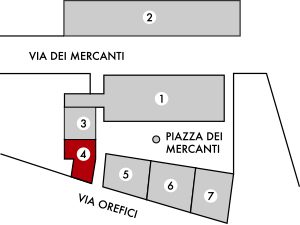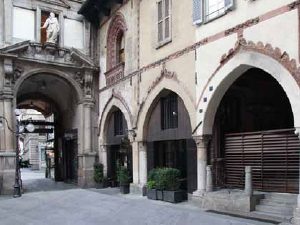Eligio visse nella Gallia (odierna Francia) del VII secolo. 
Di umili origini, guadagnò la fiducia dei re franchi Merovingi grazie alla sua abilità nell’arte orafa. Asceso al ruolo di maestro della zecca e di tesoriere, intorno ai quarant’anni si volse alla carità e alla vita religiosa, venendo poi eletto vescovo di Tournai e Noyon (641). Dopo la morte fu venerato come patrono degli orafi, dei numismatici, dei maniscalchi e dei veterinari (per un miracolo da lui compiuto a favore di un cavallo azzoppato). Gli orefici di Milano gli dedicarono una cappella nella Chiesa di San Michele al Gallo, eretta a fine ‘300 lungo la contrada che da questi artigiani prese il nome. La chiesa aveva un campanile con sopra un gallo e la sua abside confinava con la Casa dei Panigarola. Oltre alla cappella, la corporazione degli orefici sovvenzionò anche l’altare della chiesa e tutte le suppellettili che l’adornavano; all’inizio del ‘600 furono commissionati al  pittore Daniele Crespi due grandi quadri sulla vita di Sant’Eligio oggi conservati dalla famiglia Borromeo all’Isola Bella sul Lago Maggiore. Quando nel 1787 la parrocchia di San Michele fu soppressa, perché unita a quella di Santa Maria Segreta, la chiesa venne venduta per farvi all’interno tre botteghe orafe. I riusi negli anni e la ristrutturazione dell’area con la costruzione di Palazzo Venezia nel 1901, sede delle Assicurazioni Generali, ne fecero scomparire quasi ogni traccia. Al suo posto si trovano ora un bar, una libreria antiquaria e un ristorante.
pittore Daniele Crespi due grandi quadri sulla vita di Sant’Eligio oggi conservati dalla famiglia Borromeo all’Isola Bella sul Lago Maggiore. Quando nel 1787 la parrocchia di San Michele fu soppressa, perché unita a quella di Santa Maria Segreta, la chiesa venne venduta per farvi all’interno tre botteghe orafe. I riusi negli anni e la ristrutturazione dell’area con la costruzione di Palazzo Venezia nel 1901, sede delle Assicurazioni Generali, ne fecero scomparire quasi ogni traccia. Al suo posto si trovano ora un bar, una libreria antiquaria e un ristorante.
Eligius lived in seventh-century Gaul (present-day France). Although his origins
were humble, he came to the notice of the Merovingian Frankish kings thanks to his skill in the goldsmith’s art. Having been appointed master of the mint and treasurer, he then devoted himself, when he was about forty, to charitable works and the religious life, becoming as bishop of Tourney and Noyon in 641. After his death he was venerated as the patron of goldsmiths, coin collectors, farriers and veterinary surgeons (the result of a miracle he performed on a lame horse). The goldsmiths of Milan dedicated a chapel to him in the church San Michele al Gallo, built in the late fourteenth century in the quarter named after them. The church had a tower surmounted by a cock and its apse abutted on the Casa dei Panigarola. In addition to the chapel, the goldsmiths’ guild also paid for the altar in the church and all the furnishings adorning it. At the beginning of the seventeenth century the artist Daniele Crespi was commissioned to paint two large pictures representing the life of St Eligius that are now in the collection of the Borromeo family on Isola Bella in Lake Maggiore. When, in 1787, the parish of San Michele was abolished because it merged with that of Santa Maria Segreta, the church was sold and three goldsmiths’ workshops were established inside it. The different uses that were made of it over the years and the renewal of the area in 1901 with the building of Palazzo Venezia, the headquarters of the Assicurazioni Generali, caused almost all traces of it to disappear. Now, on the same site, there is a café, an antiquarian bookshop and a restaurant.